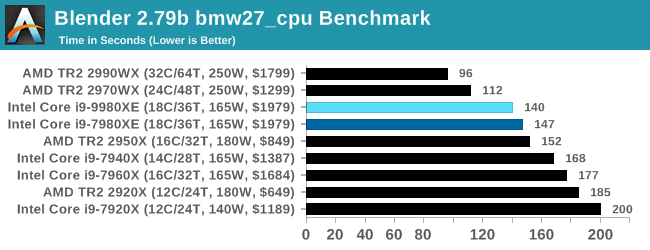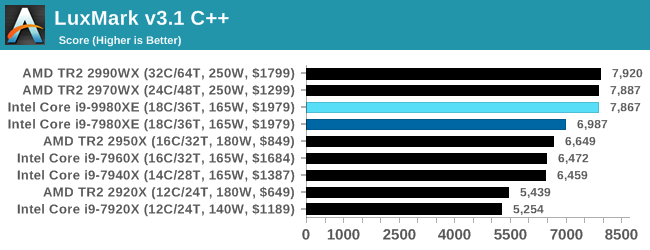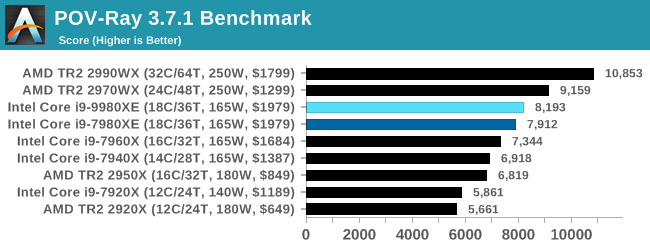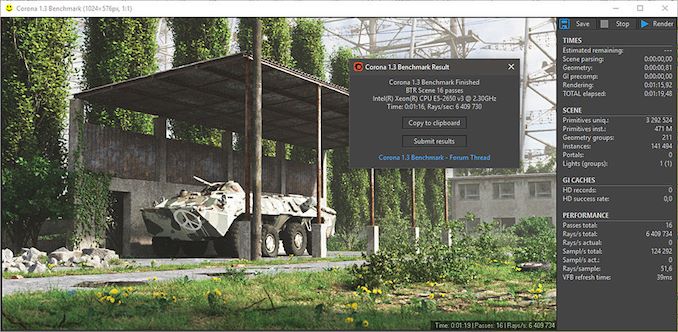The Intel Core i9-9980XE CPU Review: Refresh Until it Hertz
by Ian Cutress on November 13, 2018 9:00 AM ESTHEDT Performance: Rendering Tests
Rendering is often a key target for processor workloads, lending itself to a professional environment. It comes in different formats as well, from 3D rendering through rasterization, such as games, or by ray tracing, and invokes the ability of the software to manage meshes, textures, collisions, aliasing, physics (in animations), and discarding unnecessary work. Most renderers offer CPU code paths, while a few use GPUs and select environments use FPGAs or dedicated ASICs. For big studios however, CPUs are still the hardware of choice.
All of our benchmark results can also be found in our benchmark engine, Bench.
Corona 1.3: Performance Render
An advanced performance based renderer for software such as 3ds Max and Cinema 4D, the Corona benchmark renders a generated scene as a standard under its 1.3 software version. Normally the GUI implementation of the benchmark shows the scene being built, and allows the user to upload the result as a ‘time to complete’.
We got in contact with the developer who gave us a command line version of the benchmark that does a direct output of results. Rather than reporting time, we report the average number of rays per second across six runs, as the performance scaling of a result per unit time is typically visually easier to understand.
The Corona benchmark website can be found at https://corona-renderer.com/benchmark

Corona sees improvement in line with the frequency gain, however the higher core count AMD parts win out here.
Blender 2.79b: 3D Creation Suite
A high profile rendering tool, Blender is open-source allowing for massive amounts of configurability, and is used by a number of high-profile animation studios worldwide. The organization recently released a Blender benchmark package, a couple of weeks after we had narrowed our Blender test for our new suite, however their test can take over an hour. For our results, we run one of the sub-tests in that suite through the command line - a standard ‘bmw27’ scene in CPU only mode, and measure the time to complete the render.
Blender can be downloaded at https://www.blender.org/download/

Similarly with Blender as to Corona: the new Intel Core i9-9980XE performs better than the previous generation 7980XE, but sits behind the higher core count AMD parts.
LuxMark v3.1: LuxRender via Different Code Paths
As stated at the top, there are many different ways to process rendering data: CPU, GPU, Accelerator, and others. On top of that, there are many frameworks and APIs in which to program, depending on how the software will be used. LuxMark, a benchmark developed using the LuxRender engine, offers several different scenes and APIs. *It has been mentioned that LuxMark, since the Spectre/Meltdown patches, is not a great representation of the LuxRender engine. We still use the test as a good example of different code path projections.
In our test, we run the simple ‘Ball’ scene on both the C++ and OpenCL code paths, but in CPU mode. This scene starts with a rough render and slowly improves the quality over two minutes, giving a final result in what is essentially an average ‘kilorays per second’.

Our test here seems to put processors into buckets of performance. In this case, the Core i9-9980XE goes up a bucket.
POV-Ray 3.7.1: Ray Tracing
The Persistence of Vision ray tracing engine is another well-known benchmarking tool, which was in a state of relative hibernation until AMD released its Zen processors, to which suddenly both Intel and AMD were submitting code to the main branch of the open source project. For our test, we use the built-in benchmark for all-cores, called from the command line.
POV-Ray can be downloaded from http://www.povray.org/

POV-Ray is as expected: a performance improvement, but behind the higher core count AMD parts.












143 Comments
View All Comments
Stasinek - Wednesday, November 21, 2018 - link
It's indeed suprise to me that those new 24,32C AMD processors 2920,2970 are just worst in any therms than their 16C equivalents. In terms of perf/money perf/power just laughable.Linux changes a lot but who uses Linux and for what purpose?
I bet developers but what makes me really angry is that nobody even tries to use KVM, Xen, VirtualBox, VMware, VirtualBox as benchmarking tool for purpose of testing usage as small company server. In mine company lot of Remote Desktop sessions are connected to same server.
Someone would think - who needs good CPU? But it's only because dont used to solve real life problems and those problems are like importing big databases from obsolete programs, filtering, fixing and exporting to new ERP systems. This consumes lot of time to have fast CPU is crucial. Most of companies i know uses RDP server for that purpose and typical cheep portable laptops given to workers. To have AMD or Intel HDET tested in such purposes would be nice to see. Cause anyone can potencially have 32C anyone could benefit.. but rather than this kind test i used to see gaming.. gaming od HDET?! WTF
pandemonium - Wednesday, November 14, 2018 - link
All of these "my work doesn't have any desktop users" comments crack me up. Congratulations. Your work is not the entire world of computing in a professional space, much less prosumer space. Get over yourselves.halcyon - Wednesday, November 14, 2018 - link
@Ian CutressYour tests and review text are always a pleasure to read, thank you for the professionalism.
Questions related to the test suite (I know, everybody always wants something):
1. You are missing an Excel Spreadsheet calculation (Finance still uses a lot of these and they can peg all cores near 100% and be incredibly CPU dependent). Would be nice to see some for example an Excel Monte Carlo simulation kn the suite (local data)
2. Alternatively an R (language) based test for heavy statistical computation. Finding a one that is representative of real world workloads and strikes a balance between single core IPC and many core parallelisation might take some work. But this is one area where laptops just can't muster it and CUDA/OpenCL acceleration isn't often available at all.
3. For Web / JS framework it is nice to see SpeedoMeter and WebXPRT3, but for some reason V8 Web Tooling Bench is not there (https://v8.github.io/web-tooling-benchmark/ ). The old Kraken/JetStream/Octane are nice for reference, but not very representative of real world anymore for some time now (hence why they are abandoned).
Again thank you for this monumental work, the amount of tests is already superb!
For graphing results it would be so helpful to get a comparative price/perf graphed results browser (pick your baseline CPU, pick workloads, cpus on graph as a func of price/perf). This would enable auick viewinf of the efficient frontier in terms of price/perf for each workload and see the base CPU as an anchor.
Yeah, yeah, I know.... Just throwing this in here 😀
KAlmquist - Wednesday, November 14, 2018 - link
These benchmarks also show the 16 core TR 2950X beating the 18 core i9-9980XE in some cases.KAlmquist - Wednesday, November 14, 2018 - link
My previous comment was a reply to nexuspie's observation that, "These benchmarks show that the 9980's 18 cores often BEAT the 2990wx's 32 cores."Stasinek - Wednesday, November 21, 2018 - link
Witch should lead to conlcusion AMD Threadripper 2 is just bad offer except 2950.It's the one and only AMD CPU worh mentioning - witch means TR4 16C is dead end.
AMD offers overpriced CPUs on that platform that is for sure.
Overpriced because half of cores are choking being absolute useless.
If 32C and 4 channels is too much cores/channel imagine RYEN 3 16C on dual channel..
It will be big dissapointment for some people i bet.
Regardless of pricing Intel 9980 is just great.
Stasinek - Wednesday, November 21, 2018 - link
Is that what you wanted to say?crotach - Wednesday, November 14, 2018 - link
I have to say I'm a big fan of HEDT platforms, I built my last workstation in 2011 and it still serves me well 7 years later. But looking at this and the X299 offering I really don't see why anyone would bother.Lolimaster - Thursday, November 15, 2018 - link
Till intel changes the way it builds high core count cpu's they can't compete with AMD and it will be even worse next year when AMD made an already cheaper way to produce high core count cpu's even cheaper, to sick levels.Gasaraki88 - Thursday, November 15, 2018 - link
I'm actually more interested in the i7-9800X vs. the i9-9900K. I want to see how the overclocking is compared to the i9-9900K before I just in to X299.